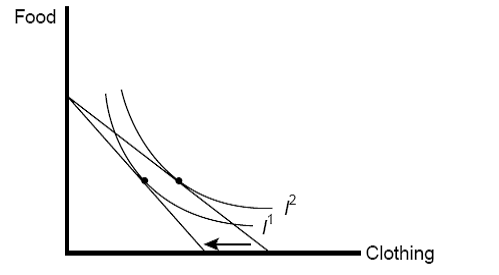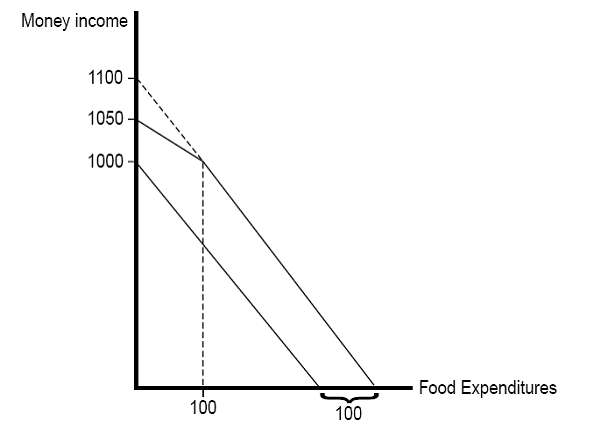Econ 172
Spring 2006
HW 3 Due Friday Feb 10
Chapter 4
Questions:
2, 4, 7 (assume that initially, there is no sales tax, and then the sales tax is implemented), 10, 16, 18,

2. Gasoline purchased
in the
4. Assume the neuter good is on the Y axis. Indifference curves are then parallel vertical lines
|
|
|
|
|
|
|
|
|
|
|
|
|
|
|
|
|
|
|
|
|
|
|||||
|
|
|
||||||
|
|
|
||||||
|
Neuter
Good |
|||||||
|
|
|
||||||
|
|
|
||||||
|
|
|
||||||
|
|
|
||||||
|
|
|
||||||
|
|
|
||||||
|
|
|
||||||
|
|
|
||||||
|
|
|
||||||
|
|
|
||||||
|
|
|
|
|
|
|
|
|
|
|
|
|
|
|
|
|
|
|
|
|
|
|
|
|
|
|
 7. (assume that initially,
there is no sales tax, and then the sales tax is implemented),
7. (assume that initially,
there is no sales tax, and then the sales tax is implemented),
Initially the budget line and indifference curve has the standard tangency along I2. When the sales tax on clothing is implemented, the budget line moves inward along the clothing axis. The new equilibrium is on I1, with less clothing consumed.
 10. The new budget line intersects the food
budget line 100 to the right of the old x axis intercept.
10. The new budget line intersects the food
budget line 100 to the right of the old x axis intercept.
At anything less than $100 worth of food (a quantity, not a price) the budget line has a kink. If $100 worth of food stamps can be sold for $50, then the composite good (money income) intercept is $1050.
16. Julia consumes anchovies A and biscuits B. When A=2 and B=2, her MRS is -1 = MUa/MUb.
Would she prefer a bundle with 3 cans of anchovies and 1 box of biscuits to a bundle with two of each? At this point, her MRS is -1. That means her marginal utility for the 2 are equal. If she has more anchovies, her MU for anchovies will diminish and if she has fewer biscuits, her MU for biscuits will rise. That means her MRS will be less than -1. If she has to trade at a one for one ratio, her utility would fall. So she won’t make the trade. Remember the MRS is at a point on the indifference curve. Any deviation from that point changes her MRS.
18. Linda’s utility function for shoes S and the number of times she goes out dancing per month T is U(S,T) = 2ST. It costs Linda $50 to buy one new pair of shoes or to spend an evening out dancing. She has $500 to spend.
a. The equation for her budget line is $500 = 50S + 50 T. She can buy a maximum of 10 shoes or 10 dancing trips.
b. Her MRS is MUs/MUt= -(∂U/∂S)/ (∂U/∂T) = -2T/2S = -T/S.
c. Her optimal bundle is where MRS = MRT . MRT = -Ps/Pt
-T/S = - Ps/Pt so –T/S = -1. Therefore T=S and 500 = 50S + 50S and 500 =100S and S = 5 and T = 5.
My questions:
1. Draw a set of indifference curves between two “bads” where a bad is defined as the more of it you have, the worse off you are, such as smog and garbage.
 Two bads, say smog and garbage, have
downward sloping indifference curves, concave to the origin. Why?
Suppose you consume a lot of smog, but not much garbage. Someone offers to take a little bit of your
smog away. You are very happy and will
willingly part with some smog, which makes you better off. But now you have to consume more garbage to
make you worse off. You’ll take a lot of
garbage in exchange for a little less smog, so the indiference curve is
relatively flat near the smog axis. As
you have less smog and more garbage, you’re not as willing to to accept the
same amount of garbage for a little less smog.
Two bads, say smog and garbage, have
downward sloping indifference curves, concave to the origin. Why?
Suppose you consume a lot of smog, but not much garbage. Someone offers to take a little bit of your
smog away. You are very happy and will
willingly part with some smog, which makes you better off. But now you have to consume more garbage to
make you worse off. You’ll take a lot of
garbage in exchange for a little less smog, so the indiference curve is
relatively flat near the smog axis. As
you have less smog and more garbage, you’re not as willing to to accept the
same amount of garbage for a little less smog.
The other, and more important difference, is that utility increases as you get closer to the origin.
|
|
|
|
|
|
|
|
||||
|
|
|
|
|
|
|
|
||||
|
|
|
|
|
|
|
|
||||
|
|
|
|
|
|
|
|
||||
|
|
|
|
|
|
|
|
||||
|
|
|
|
|
|
|
|
||||
|
|
|
|
|
|
|
|
||||
|
|
|
|
|
|
|
|
||||
|
|
|
|
|
|
|
|
||||
|
|
|
|
|
|
|
|
||||
|
|
|
|
|
|
|
|
||||
|
|
|
|
|
|
|
|
||||
|
|
|
|
|
|
|
|
||||
|
|
|
|
|
|
|
|
||||
|
|
|
|
|
|
|
|
||||
|
|
|
|
|
|
|
|
||||
|
|
5 |
|
|
|
|
|
||||
|
|
|
|
|
Car Washes |
|
|||||
2. Most of the time, a consumer can purchase as much of a good as she wants at an unchanged price. Sometimes, however, we can get a discount for multiple purchases. Suppose Julia can pay $10 to wash her car five times but if she washes her car more than five times, she is only charged $5 per car wash for more than 5 washes. What does her budget line look like (draw it and explain it) if car washes is on one axis and all other goods is on the other axis?
The budget line
has a slope of -10 (assuming the CG costs $1) up to the point where she has 5
car washes. After 5, the slope of the
budget line is half of -10, or -5.
3. The National Highway Transportation Safety Administration (NHTSA—or nitsa) required front air bags in cars in 1997. But air bags had been available as early as the 1970s and were widely available by the mid to late 1980s. Consumers were aware that air bags saved lives and reduced injuries, yet many did not purchase them. Can you explain this or must we assume consumers were not behaving rationally (Hint: They were rational so I won’t accept that as an answer.)
If we draw a
budget line with air bags and the composite good then there must have been a
corner solution for the consumers who did not purchase air bags.
4. You can buy newspapers and candy bars from (different) vending machines. Use the concept of dimishing marginal utility to explain why newspaper vending machines allow you to open the box and essentially do not limit the number of newspapers you are able to take out of the machine while candy bar vending machines only dispense one candy bar at a time.
Most people get
utility from one newspaper but the MU you get from having 2 newspapers is low,
or 0. Therefore, you only take one out
of the machine even though you could take more.
If the same held true for a candy bar machine, most people would
probably take a lot of candy bars since the MU of the second candy bar is less
than the first, but certainly not zero.
